Donegal - pt 2
Mar 19 Today is Mother's Day in Ireland, which is celebrated three weeks before Easter. We thought of our moms and know that they are having a happy day in heaven. 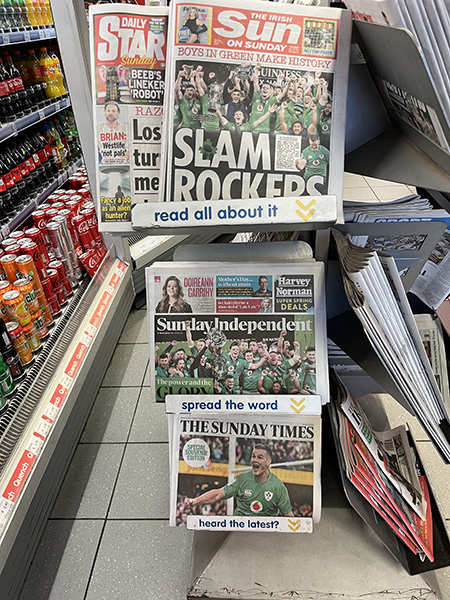
Rugby victory makes headlines We rose in time to get to breakfast a little after 8 am and then were out the door of the hotel for a drive to Killybegs, about 22 km west of Donegal town. This place gets its name from the Gaelic term na Cealla Beaga or "little cells," which refers to stone beehive huts built for an early monastic settlement, perhaps around the 6th century. The village sits on a deep sea harbor and is home to a fleet of fishing boats. Its reputation as a safe harbor goes back many centuries and includes the ships of the Spanish Armada, a couple of which put in port at Killybegs after their defeat by the British and Dutch fleet in 1588. It was the last port of call for La Girona, a Spanish galleass which limped into Killybegs harbor with a damaged rudder. She was repaired through the assistance of the local Irish chieftain, MacSweeney Bannagh, and set sail for Scotland. On the way, however, she sailed into a storm and sank off the north coast of County Antrim with an estimated loss of 1,300 souls. The nine survivors were sent on to Scotland by the local clan leader at Dunluce Castle, Sorley Boy McDonnell. 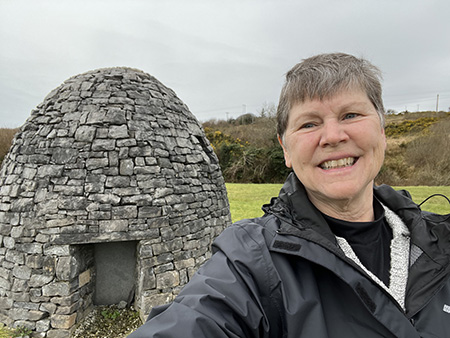
Replica of one of the cells 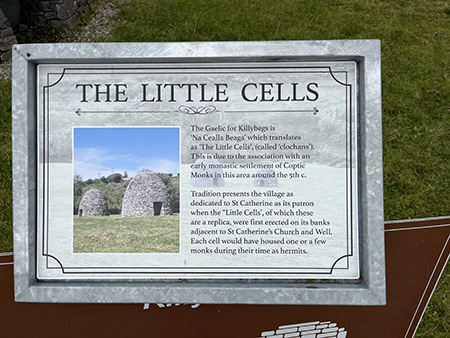
The Gaelic words for "little cells" gave Killybegs its name 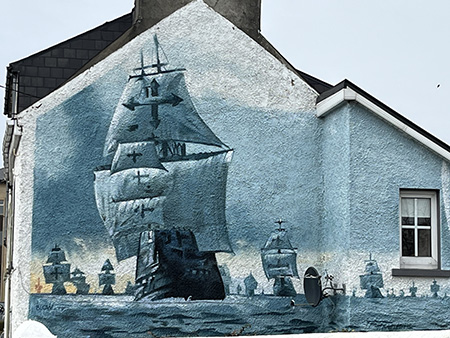
Spanish Armada mural in Killybegs When we reached the village of Killybegs, we parked and walked around the harbor to see the various ships of the fishing fleet. They were enormous and equipped with heavy equipment for catching and pulling in large catches of fish from the North Atlantic. 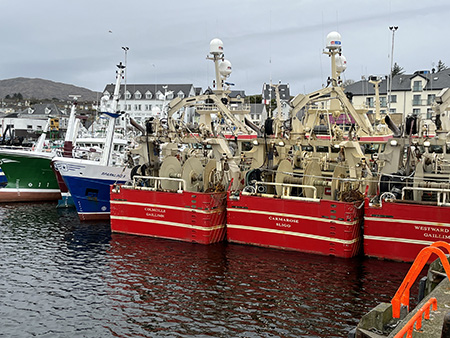
Fishing ships in Killybegs harbor 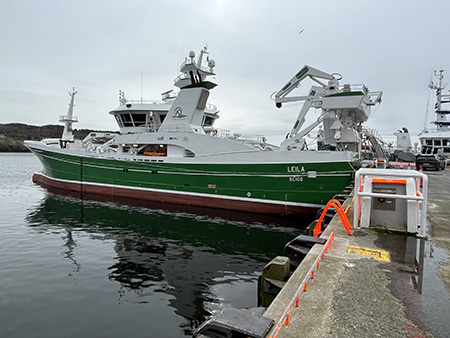
In Killybegs harbor 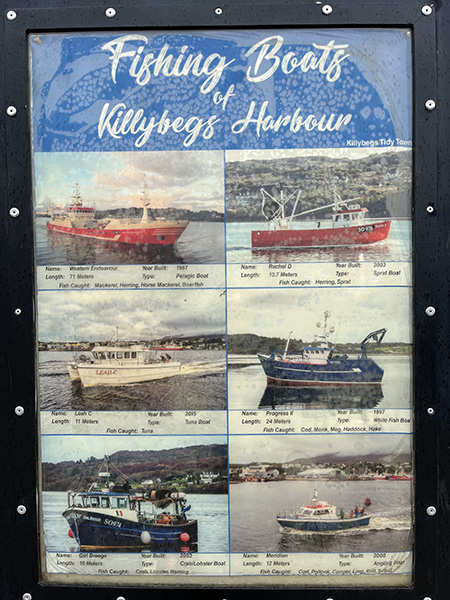
Types of ships in the fishing fleet After taking some photos and reading some of the information placards on the docks at Killybegs, we got back in the car and drove a little further west, in search of an overlook we saw on the map near Largy, County Donegal. We figured the overlook would provide us with a good vantage point from which to view the coastline. But before we reached the roadside lay-by outside of Largy, we saw a sign for the Fintra Beach and turned down the steep road (30% grade) to a beautiful sandy beach in a cove. 
Road to Fintra Beach 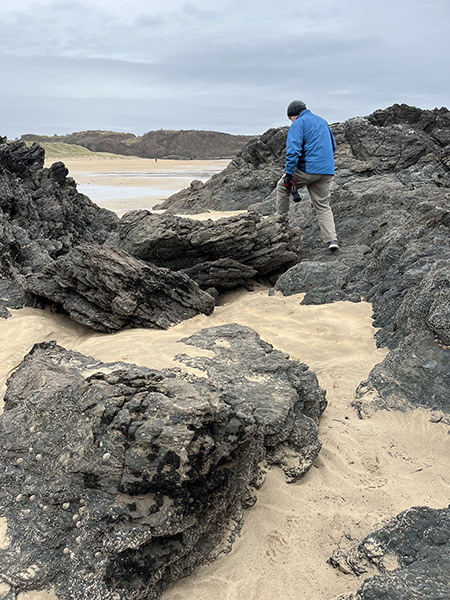
On Fintra Beach 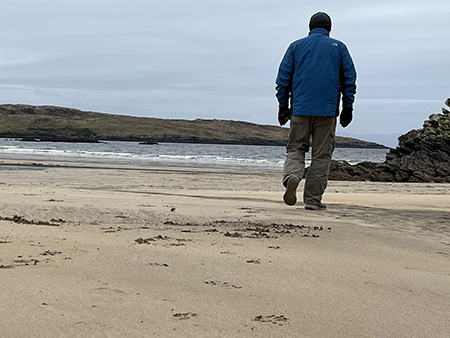
Steve walking on Fintra Beach We found a small car park at the base of the hill and saw that a few others were also stopping there for a stroll or look-see. We parked and got out to walk on the beach, which was open for a distance of about 100 yards because it was low tide. Here and there were a few people walking their dogs, jogging or strolling on the beach. We took some photos, admired the view and were heading back to our car when Steve nudged me and pointed off to our left. There was a group of five women, in swimming suits, heading for the open water to take a dip in the North Atlantic. It was a brisk and rainy morning, with the air temperature of about 44 degrees (F), so not exactly balmy weather. But these women looked as if this was some familiar to them as they calmly walked into the surf, swam out into the water until their shoulders were submerged and stayed there for several minutes. 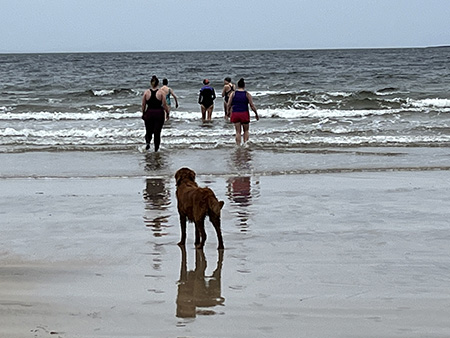
Five women going for an ocean swim They emerged from the cold, gray Atlantic just as they had gone in - at ease and walking casually. Not a one of them was screeching or even clutching a towel. They headed back to their respective cars, taking their time and occasionally speaking to incredulous passersby. Two of the women walked up to a car parked behind us, so I jumped out and asked them about their swim. They told me that it is something that they have been doing for a long time and they try to do it as many times a week as possible. I asked if they exercised beforehand (e.g, warmed up by jogging or some other means). "Some do," they said, "but we don't." They were taking off their rubber shoes, opening thermoses and pour water into a basin, and then they stepped in. "Are you just washing the salt water off your feet?" I asked. "We're warming our feet," was the reply. The two I was speaking to looked to be women aged around 30 and 40, though it was hard to tell since they were very fit-looking. I told them they were inspiring and let them get back to warming themselves. I went back to our car, where Steve had the heater running so we could warm ourselves from our short stroll on the strand. Fintra Beach was the site of a plane crash of an American B-17 in 1944. (https://aviation-safety.net/wikibase/97863 ) The crew was ferrying the plane from Nebraska to Scotland when they encountered severe weather and were hit by lightning. They ditched the plane near Fintra Beach. Though everyone on board was injured, their injuries were not severe, and all five were able to get in a lifeboat and make it to shore. They were taken in by the locals, given assistance and returned to the Allies. (Ireland was officially neutral during "The Emergency," the term which the Irish used to refer to WW2, though in 1941 with heavy pressure from Great Britain and the U.S., who had not yet entered the war, they agreed to allow Allied aircraft to cross a narrow strip of airspace across the Republic of Ireland at Donegal in order to reach British bases in Northern Ireland. It wasn't publicized at the time, but the "Donegal Corridor" allowed the Allies to avoid a more dangerous route to the north or south. After we left the beach, we drove up the steep hill and back to the road to take us to the overlook on the road to Largy. It was a nice vista, and we paused their briefly and took some photos. Since we needed to be back in Donegal in time for our appointed 3 pm water boat tour of the harbor, we didn't drive any further west and instead turned around and headed back to Killybegs to find a place to have a cup of tea. 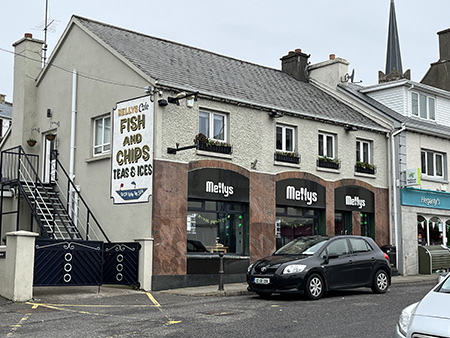
Fish and chips shop in Killybegs The Tara Hotel restaurant was open, but the best tables at their big bay window were reserved for parties coming in for the mid-day meal (for Mother's Day), so we took a small table near the window and ordered our tea. We didn't linger much longer than it took to finish off the pot of tea and a couple of ginger biscuits, and we were on our way back to Donegal town. We checked in at the office of the water boat tour company, purchased our tickets for this afternoon's tour and were instructed to be at the boat dock by 2:45. This gave us enough time to go back to the hotel room and refresh ourselves. 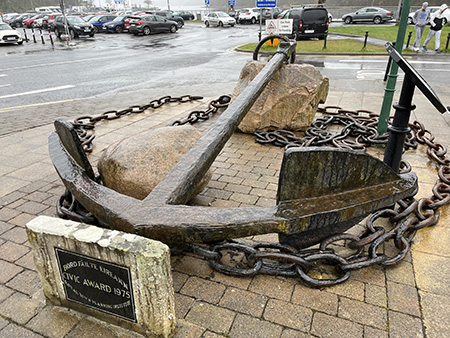
The anchor of Romaine, one of three ships from a small French fleet which arrived at the Donegal harbor in September 1798 to assist with the Irish Rebellion. When they spotted British ships arriving, they cut the anchor tether and fled. Just before we joined the boat tour, we strolled down the dock and found the statue of Aodh Ruadh Ó Domhnaill (Red Hugh or Rory O'Donnell), perhaps better known as the fighting prince of Donegal. He became the chieftain of the clan of O'Donnell and the Lord of Tyrconnell in 1593. He led an alliance of Irish clans in the Nine Years' War against the English. He was defeated in the Siege at Kinsale, and sought asylum in Spain but died there in 1602 before he could regroup the alliance. 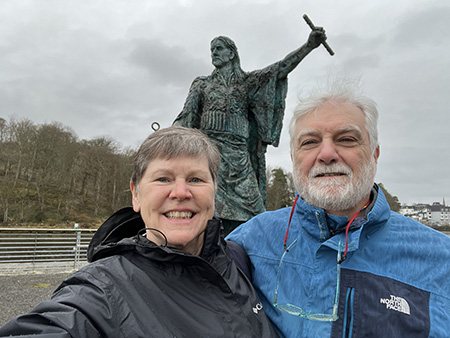
With the fighting prince of Donegal The harbor tour took a route around the inner harbor of Donegal, where sites along the shore or on small islands were pointed out. The memorable ones included the abandoned ticket office of the White Star Line, a small, tin-roofed cottage where thousands of desperate Irish families purchased a £2 ticket to board a ship to leave the Emerald Isle during the years of the Great Hunger. From that point, they were often made to wait - sometimes weeks - before being put aboard smaller vessels and transported out to the sailing ships anchored in a deeper part of the harbor. If they made it that far - hundred are buried onshore in unmarked graves of a "famine cemetery" - most of them never saw Ireland again. 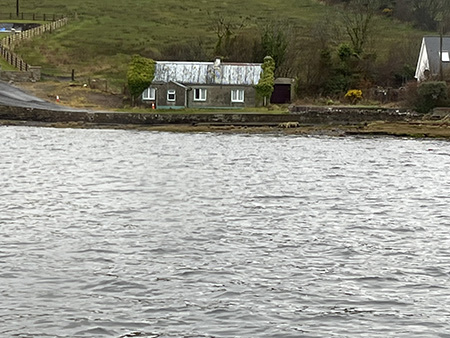
Formerly a ticket office for the White Star Line Further on in our tour, the guide pointed out the oyster banks and the area on the western horizon where we might have been able to see Benbulbin, a flat-top rock formation in County Sligo, more than 25 miles to the southwest. I would have liked to see Benbulbin because I remember its curious form in the photos that Mother showed me from her trip long ago. But it was impossible in today's weather to see much further than a mile away. At the turnaround point in our tour, we were near the place where the seal colony thrives, and after a minute or two we did see a few little dark head break the water and greet us. We were told that on a warmer day or at lower tide, we would have seen many dozens of them. Other sites pointed out on the tour were the ancestral home of Senator John B. Connally, Jr., the Donegal Golf Course, and the home of poet Seumas MacManus. After the boat tour, we needed to warm ourselves and get a meal, so we parked at a table in the Olde Castle Bar and ordered meals of Donegal oysters and sandwiches. After dinner, we set off for a stroll down the Fairy Bank Trail, a feature on the north bank of the inlet of Donegal bay that was pointed out on the boat tour. It's a paved walk through the woods with a residential area on one side and the bay inlet on the other. The trees are old and covered in moss, and at several places we saw tiny doors and window or other features on the trees, evidence of the fairies residing there. It was perfect weather to see the little creatures, though none made themselves known to us as we walked through a heavy mist in a fast-falling evening grayness. Nevertheless, as we left, we stopped and thanked the fairies for letting us walk through their woods. 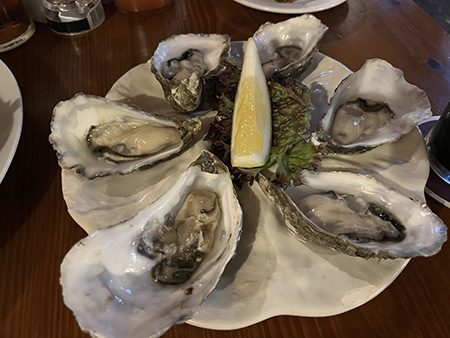
A plate of fresh oysters 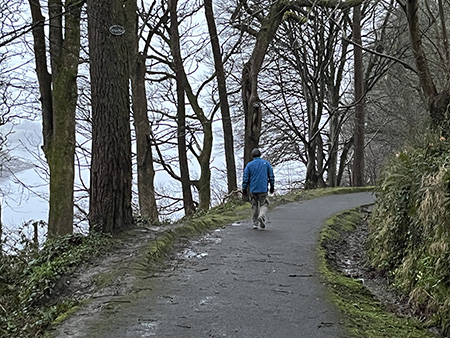
Fairy bank trail 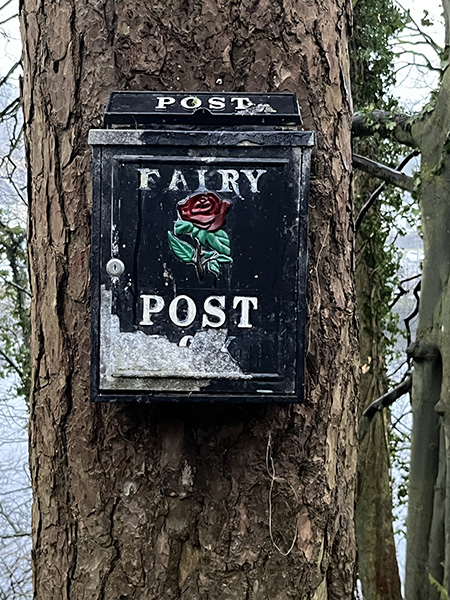
Along the trail 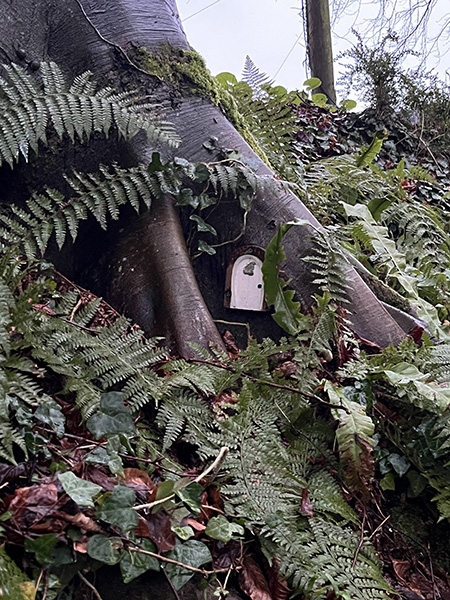
Door to a fairy home 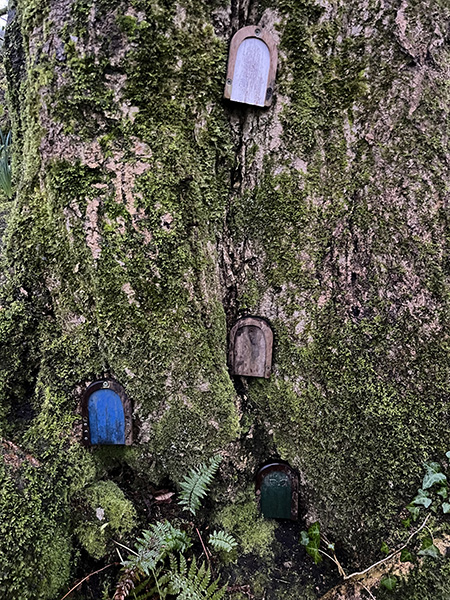
A veritable fairy subdivision 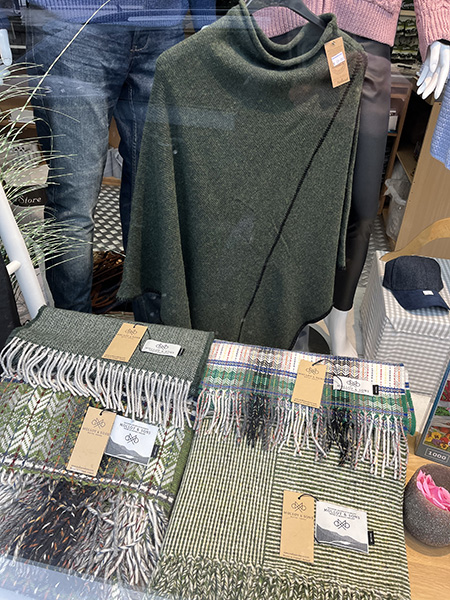
Donegal tweed in the shops We headed back to the hotel and up to our room, resisting the temptation to stop and listen to the three-man group playing traditional tunes in the bar. We have an ambitious plan tomorrow to cover several miles and yet arrive in Derry in time to visit a museum and see a few things before dark. We're going to try to get on the road by 9 am. 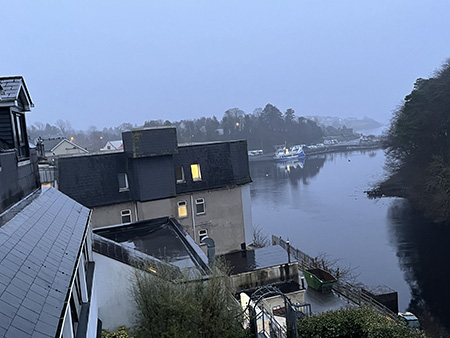
View from our hotel room onto the River Eske and inlet to Donegal harbor Next: North to Derry |
| Other stuff |
|
back to the top |